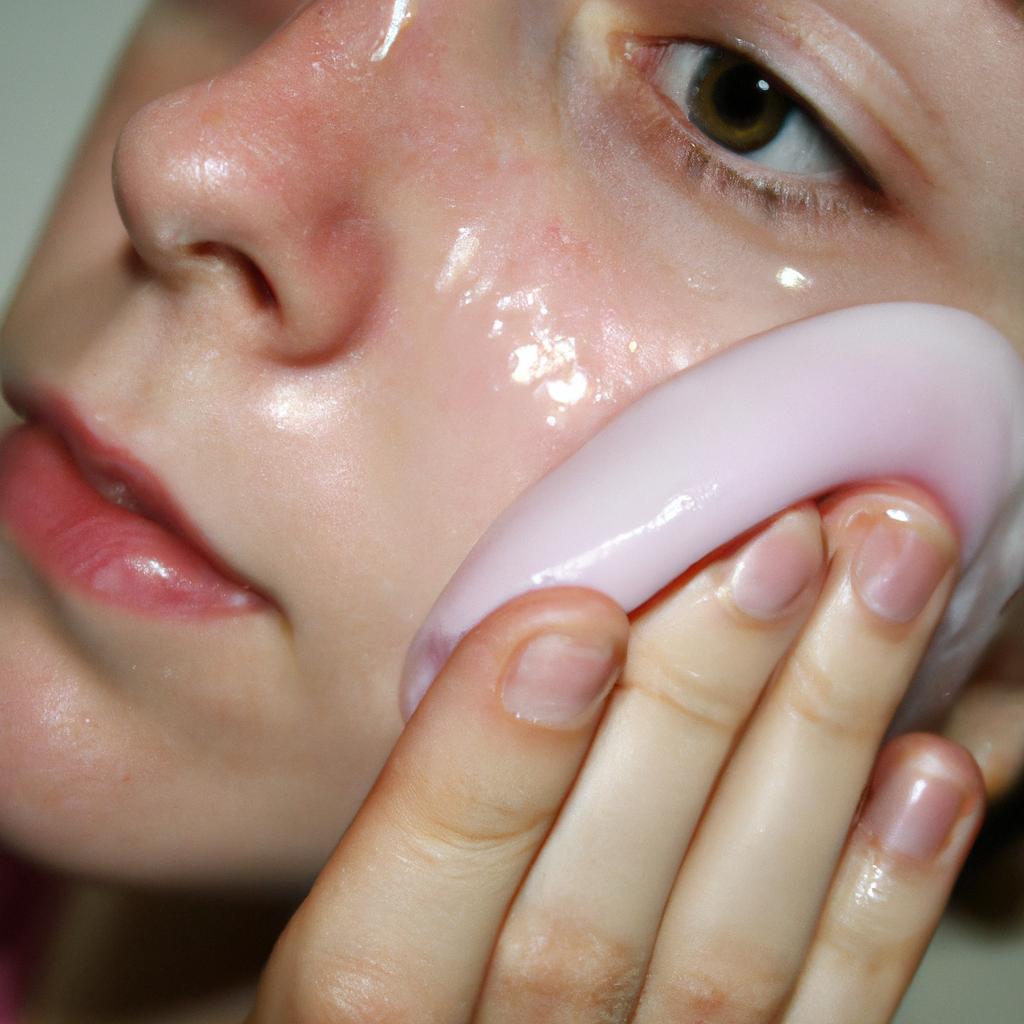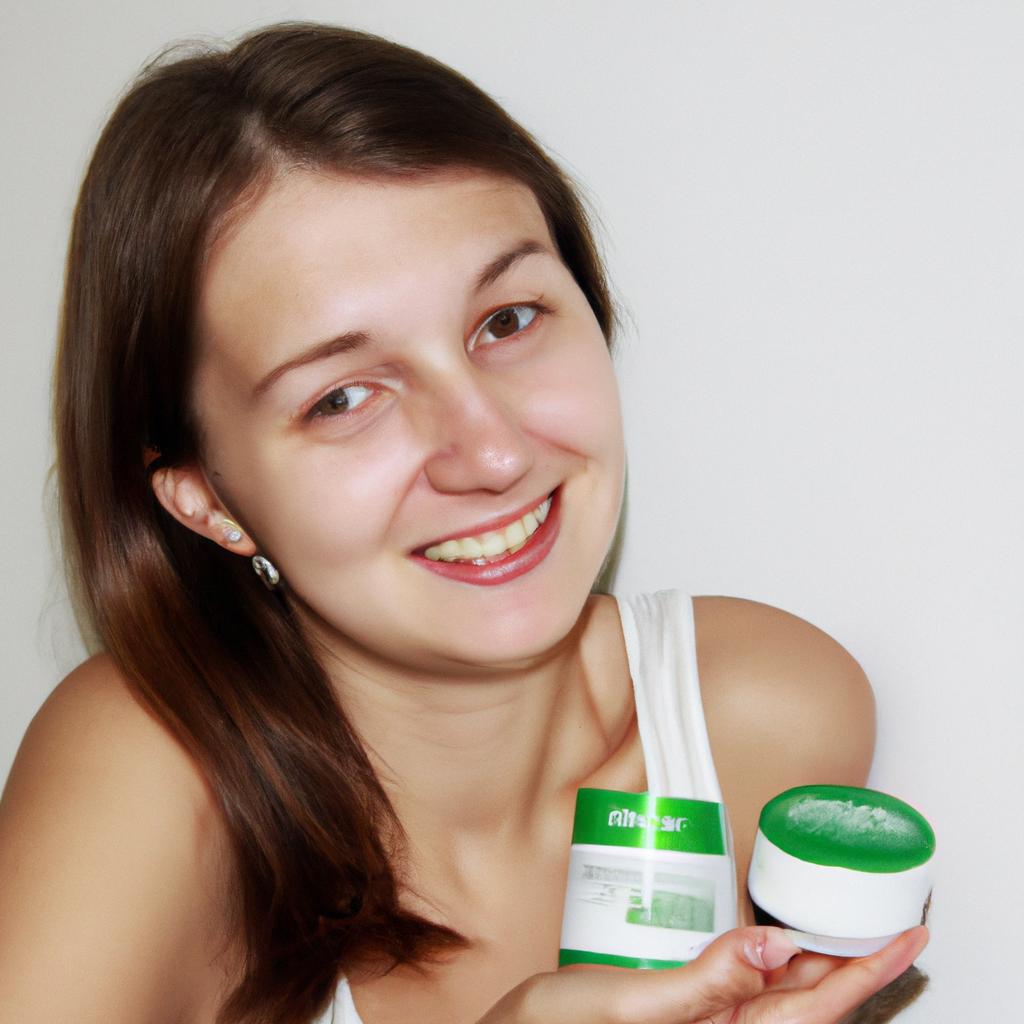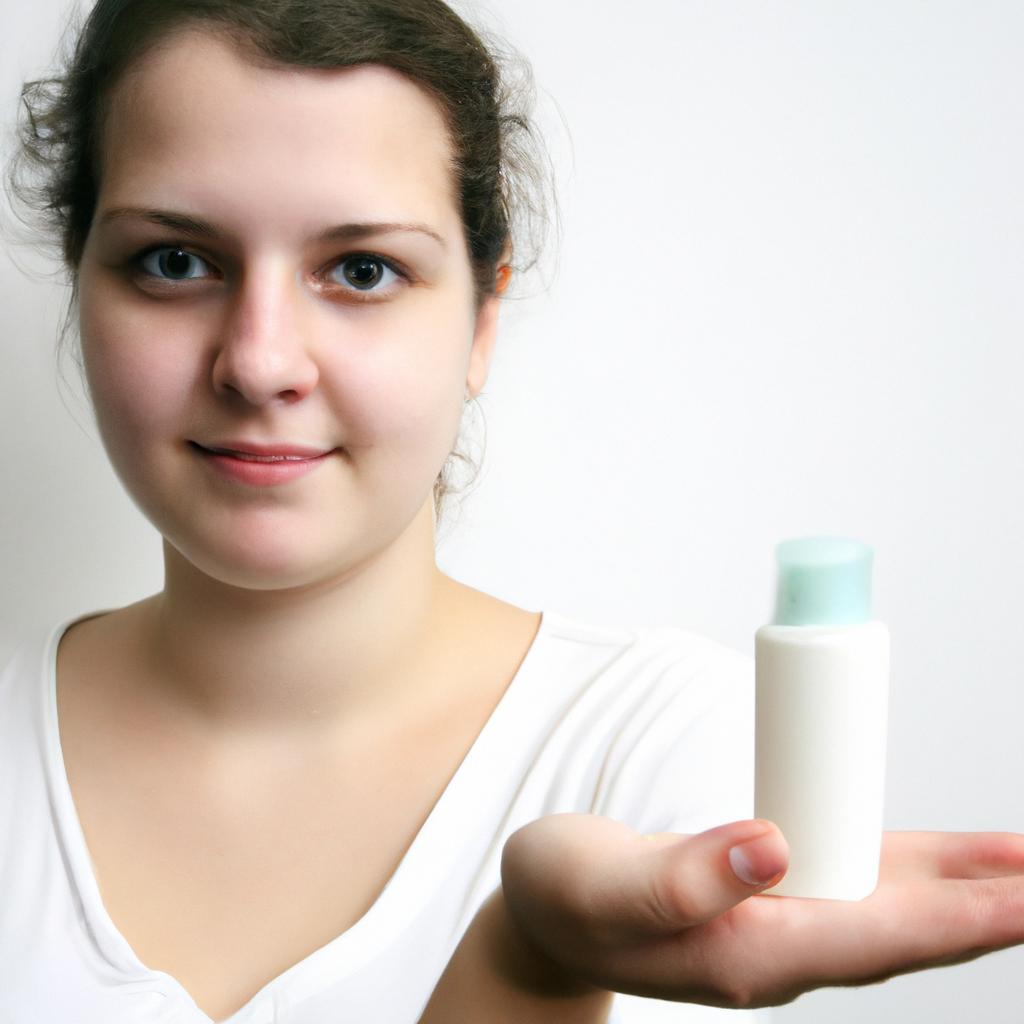Skin care is an essential aspect of maintaining healthy and radiant skin. Proper moisturization plays a crucial role in achieving optimal hydration levels, which are vital for maintaining the skin’s elasticity and overall health. This article aims to explore the significance of moisturizing as part of a comprehensive skincare routine and emphasizes the importance of using suitable products.
Imagine a scenario where an individual with dry and dull skin struggles to find effective solutions to restore their skin’s natural moisture balance. Despite diligent cleansing and exfoliating routines, they notice that their skin still feels tight, flaky, and lacks vitality. In this case study, it becomes evident that proper moisturization can be the missing link in their skincare regimen. Moisturizers act as a protective barrier on the skin’s surface by sealing in moisture, preventing water loss, and replenishing essential nutrients necessary for healthy cell function. Therefore, understanding how to choose appropriate moisturizing products tailored to specific skin types is instrumental in achieving long-lasting hydration and rejuvenation.
In recent years, advancements in cosmetic technology have led to an overwhelming variety of moisturizing products available in the market. However, without careful consideration and awareness of individual needs, users may end up selecting ineffective or even harmful options. Thus, it is imperative to comprehend the basics of moisturizers and their key ingredients to make informed choices.
Firstly, understanding one’s skin type is crucial in determining the appropriate moisturizer. Dry skin requires heavier, oil-based moisturizers that provide deep hydration and nourishment. On the other hand, oily or combination skin benefits from lightweight, water-based moisturizers that offer hydration without clogging pores. Additionally, sensitive skin types should opt for fragrance-free and hypoallergenic formulas to avoid irritation.
When selecting a moisturizer, it is essential to consider its key ingredients. Hyaluronic acid is a popular ingredient known for its ability to attract and retain moisture in the skin, resulting in plumpness and improved texture. Glycerin and ceramides are other hydrating agents that help strengthen the skin’s barrier function and prevent moisture loss. For individuals with dry or mature skin, ingredients like shea butter and oils such as jojoba or argan can provide intense nourishment and restore suppleness.
To maximize the effectiveness of a moisturizer, proper application techniques are important. After cleansing and toning the face, apply a small amount of moisturizer onto damp skin using gentle upward motions. This helps lock in moisture absorbed from previous skincare steps and ensures even distribution of the product across the face and neck.
In conclusion, incorporating an effective moisturizer into one’s skincare routine is vital for achieving healthy, hydrated, and radiant skin. Understanding individual needs based on skin type and selecting suitable products with beneficial ingredients are key factors in attaining optimal results. By prioritizing proper moisturization alongside regular cleansing and exfoliation routines, individuals can address concerns related to dryness, dullness, or tightness while promoting overall skin health.
Understanding the Importance of Moisturizing
Imagine a scenario where two individuals are exposed to the same harsh environmental conditions. Person A, who regularly moisturizes their skin, experiences minimal discomfort and maintains a healthy complexion. On the other hand, person B neglects proper hydration practices and suffers from dryness, tightness, and irritation. This example highlights the significance of moisturizing in maintaining optimal skin health.
Moisturizing plays a crucial role in nourishing and protecting our largest organ – the skin. By replenishing lost moisture, it helps establish a protective barrier that shields against external aggressors such as pollution, UV radiation, and harsh weather conditions. Moreover, adequate hydration promotes elasticity and suppleness, preventing premature aging signs like fine lines and wrinkles.
To further emphasize the importance of incorporating moisturizers into your skincare routine, consider these key benefits:
- Hydration: Properly moisturized skin retains water content more effectively, preventing dryness and promoting overall comfort.
- Barrier Function: The application of moisturizers strengthens the skin’s natural protective barrier by sealing moisture within its layers.
- Improved Texture: Regular use of moisturizers can help smoothen rough patches or uneven texture for a softer feel.
- Long-term Health: Consistent moisturization aids in maintaining overall skin health while minimizing potential future damage caused by dehydration.
| Benefit | Description |
|---|---|
| Hydration | Prevents dryness and keeps the skin comfortable |
| Barrier Function | Reinforces the natural protective barrier by retaining moisture |
| Improved Texture | Smoothens rough patches on the skin surface |
| Long-term Health | Maintains overall skin health; reduces potential long-term damage caused by dehydration |
Incorporating regular moisturization into your daily skincare routine is essential for achieving hydrated and healthy-looking skin. By understanding why this step is vital to your skincare regimen, you can make informed decisions regarding product selection and usage.
Transitioning into the subsequent section, let us now explore how identifying your skin type is crucial for effective hydration.
Identifying Your Skin Type for Effective Hydration
Building on the understanding of why moisturizing is important, let us now delve into identifying your skin type to ensure effective hydration. By recognizing your specific skin needs, you can select the right products and techniques that will provide optimal results.
To illustrate the significance of knowing your skin type, let’s consider a hypothetical case study. Imagine Sarah, who struggles with dry patches on her face despite regularly moisturizing. She decides to investigate further and discovers that she has combination skin – oily in some areas while dry in others. Armed with this knowledge, Sarah can now tailor her skincare routine accordingly.
Understanding your own skin type allows you to address its unique requirements and achieve maximum hydration. Here are key indicators to help identify common skin types:
-
Normal Skin:
- Balanced moisture levels
- Few imperfections or blemishes
- Smooth texture
-
Dry Skin:
- Lack of natural oils
- Tightness or itchiness
- Flaky or rough appearance
-
Oily Skin:
- Excess sebum production
- Shiny complexion
- Prone to breakouts
-
Combination Skin:
- Mix of oily and dry areas
- Oilier T-zone (forehead, nose, chin)
- Drier cheeks
By referring to this table, you can start pinpointing which category best describes your skin type:
| Skin Type | Characteristics |
|---|---|
| Normal | Balanced moisture levels |
| Dry | Lack of natural oils |
| Oily | Excess sebum production |
| Combination | Mix of oily and dry areas |
Recognizing your specific skin type empowers you to make informed decisions when selecting appropriate moisturizers tailored precisely for your needs. This ensures that you target problem areas effectively while maintaining an overall healthy skin balance. In the subsequent section, we will explore how to choose the right moisturizer for your particular skin type.
With a clear understanding of your skin type, you can now turn your attention to selecting the ideal moisturizer that will provide optimal hydration and nourishment.
Choosing the Right Moisturizer for Your Skin
Imagine a hypothetical scenario: Sarah, a 30-year-old woman, has been struggling with dry and flaky skin despite regular moisturizer application. She wonders if she is using the right product or if there might be something else affecting her skin’s hydration levels. In this section, we will explore how to identify your skin type accurately to ensure effective hydration.
Determining your skin type can significantly impact the effectiveness of your moisturizing routine. Here are some key indicators that can help you determine which category your skin falls into:
-
Oily Skin:
- Excessive shine on the face throughout the day
- Visible pores, especially in the T-zone (forehead, nose, and chin)
- Frequent occurrence of acne or blemishes
-
Dry Skin:
- Tightness or discomfort after cleansing
- Rough texture and visible flakes
- Prone to fine lines and wrinkles
-
Combination Skin:
- Presence of both oily and dry areas on the face
- Often an oily T-zone while other parts remain dry
- Potential for breakouts in oily regions
-
Normal/Neutral Skin:
- Well-balanced moisture levels without excessive oiliness or dryness
- Few imperfections or sensitivity issues
| Skin Type | Characteristics |
|---|---|
| Oily | Excessive shine, visible pores |
| Dry | Tightness after cleansing, rough texture |
| Combination | Both oily and dry areas |
| Normal/Neutral | Balanced moisture levels |
By recognizing their unique characteristics, individuals like Sarah can make informed decisions when choosing suitable moisturizers that provide optimal hydration for their skin type. In the subsequent section, we will explore how to apply these moisturizers correctly for maximum benefit and absorption.
Transitioning into the next section about “Proper Application Techniques for Maximum Hydration,” it is essential to understand that using the right moisturizer alone may not be sufficient in achieving optimal hydration. Therefore, let’s delve into effective application techniques that can enhance your skincare routine and ensure long-lasting moisture for healthy-looking skin.
Proper Application Techniques for Maximum Hydration
Achieving hydration and maintaining healthy skin requires more than just choosing the right moisturizer. Proper application techniques play a crucial role in maximizing the benefits of your skincare products. By following these guidelines, you can ensure that your skin receives the hydration it needs for a radiant complexion.
Consider the case of Sarah, who struggled with dry and flaky skin despite using various moisturizers. After consulting a dermatologist, she discovered that her incorrect application technique was preventing her skin from absorbing the product effectively. This realization prompted her to adopt proper methods, resulting in noticeable improvements in her skin’s hydration level and overall appearance.
To achieve maximum hydration, keep these tips in mind:
-
Cleanse before applying: Before applying moisturizer, cleanse your face thoroughly to remove any dirt or impurities that may hinder absorption. A clean canvas allows the moisturizer to penetrate deeply into your skin and lock in moisture effectively.
-
Use gentle patting motions: When applying moisturizer, avoid rubbing or pulling on your skin as this can cause irritation and damage over time. Instead, use gentle patting motions with your fingertips to evenly distribute the product across your face and neck.
-
Focus on problem areas: If you have specific areas of concern like dry patches or fine lines, pay extra attention to those areas when applying moisturizer. Gently massage the product onto these problem spots using circular motions to help stimulate blood circulation and improve absorption.
-
Don’t forget about sunscreen: Moisturizing alone is not enough; incorporating sunscreen into your daily routine is essential for protecting your skin from harmful UV rays. Look for a moisturizer with built-in SPF or apply sunscreen separately after allowing the moisturizer to absorb fully.
Emphasize self-care by prioritizing regular skincare routines:
| Self-Care Tips |
|---|
| Adequate sleep |
| Balanced diet |
| Drinking plenty of water |
These lifestyle factors can contribute to overall skin health and enhance the benefits of moisturizing.
By implementing these proper application techniques and incorporating self-care practices, you can maximize the effectiveness of your moisturizer. In turn, this will help improve your skin’s hydration levels, leaving it healthy, supple, and glowing.
Transitioning into the subsequent section about “Additional Tips for Enhancing Moisturizing Benefits,” it is essential to explore other methods that go hand-in-hand with proper product usage. These tips can further support your skincare routine and promote optimal skin hydration.
Additional Tips for Enhancing Moisturizing Benefits
Imagine this scenario: Sarah, a 35-year-old woman with dry and dehydrated skin, diligently applies moisturizer every morning and night. However, despite her efforts, she still finds herself struggling to achieve the desired level of hydration. What could be going wrong? In this section, we will explore some essential techniques that can help you maximize the benefits of your moisturizing routine.
To begin with, it is crucial to cleanse your face before applying any moisturizer. By removing dirt, oil, and other impurities from your skin’s surface, you create a clean canvas for better product absorption. Gently washing your face using a mild cleanser helps ensure that the moisturizer penetrates deeply into your skin layers.
Once your face is clean and ready, consider incorporating these expert-approved application techniques:
-
The Patting Technique: Instead of rubbing or massaging the moisturizer onto your skin, try patting it gently in an upward motion. This technique promotes blood circulation while minimizing unnecessary tugging on delicate facial tissues.
-
Use Adequate Product: It is important to use an adequate amount of moisturizer to cover all areas of your face and neck thoroughly. Remember that applying too little may not provide sufficient hydration, while excessive amounts may leave behind a greasy residue.
-
Allow Time for Absorption: After applying the moisturizer, give it a few minutes to absorb fully before proceeding with makeup application or exposing yourself to external elements such as sunlight or wind.
Now let’s take a closer look at how each of these techniques can contribute to maximum hydration by examining the following table:
| Technique | Benefit |
|---|---|
| Cleansing | Preparing the skin for optimal product |
| absorption | |
| Patting | Promoting blood circulation |
| without causing stress on | |
| facial tissues | |
| Sufficient Product | Ensuring all areas are covered adequately |
| without being too greasy | |
| Allow Absorption | Giving the moisturizer enough time to |
| penetrate deep into the skin |
By following these application techniques, you can enhance the effectiveness of your moisturizing routine and achieve maximum hydration for healthier-looking skin.
Moving forward, let’s explore common mistakes that people often make while moisturizing in order to avoid them and optimize our skincare efforts.
Common Mistakes to Avoid in Moisturizing
Enhancing Moisturizing Benefits: Additional Tips
Building upon the previous section’s discussion on enhancing moisturizing benefits, this segment provides further insights and recommendations to effectively maximize hydration for optimal skin care results. To illustrate these tips in action, let’s consider a case study of Sarah, a 30-year-old woman with dry skin.
Firstly, it is crucial to choose the right type of moisturizer based on individual needs. With an abundance of options available, understanding your skin type can guide you towards selecting the most suitable product. For instance, Sarah has dry skin that often feels tight and lacks natural moisture. A thick cream-based moisturizer containing ingredients like hyaluronic acid or ceramides would be more beneficial for her compared to lighter lotions or gels.
To ensure proper application and absorption of moisturizers, it is essential to follow these guidelines:
- Gently cleanse your face before applying moisturizer.
- Use upward motions when spreading the product onto your skin.
- Avoid excessive rubbing or stretching of the facial area.
- Allow sufficient time for the moisturizer to fully absorb into the skin before proceeding with other skincare steps.
Furthermore, incorporating additional hydrating practices into your routine can amplify the effectiveness of moisturizers. Consider implementing these habits:
| Hydration Habits | Benefits |
|---|---|
| Drinking plenty of water throughout the day | Hydrates from within and improves overall skin health |
| Using a humidifier at home | Increases humidity levels in indoor spaces, preventing moisture loss |
| Consuming foods rich in antioxidants and healthy fats | Nourishes the skin from within and promotes moisture retention |
By adopting such practices alongside regular use of appropriate moisturizers, individuals can significantly enhance their skin’s hydration levels.
In conclusion, achieving optimal hydration through proper product usage requires choosing appropriate moisturizers tailored to one’s specific needs as well as following recommended application techniques. Additionally, incorporating hydrating habits into daily routines can further amplify the moisturizing benefits. By employing these strategies, individuals like Sarah can effectively combat dry skin and achieve a well-nourished complexion.
Remember, maintaining healthy and hydrated skin is an ongoing process that requires consistency and diligence in your skincare routine.
 Stanley Beauty Care
Stanley Beauty Care



